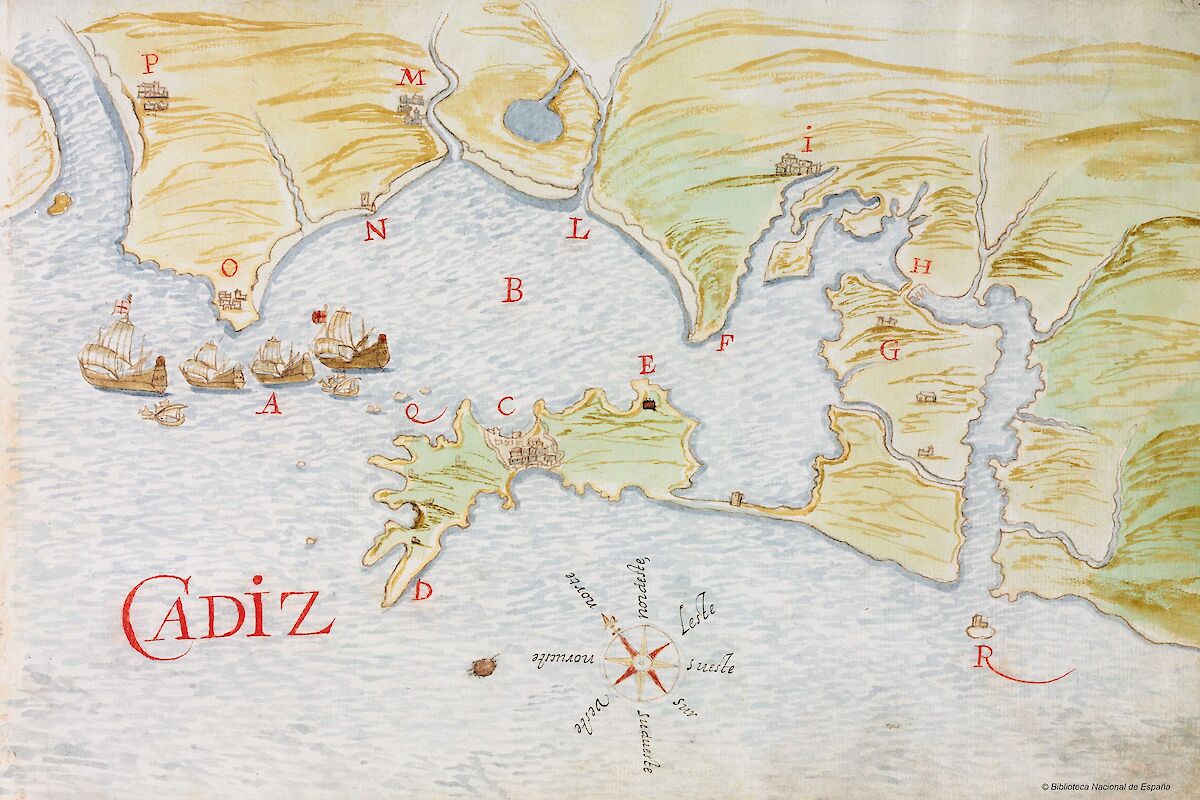Cadiz (ESP)

Cádiz, Nicolás de Cardona, 1632, Biblioteca Nacional
Because of the strategic position of the port of Cadiz between the Atlantic and the Mediterranean and its proximity to Africa, this port has been used since ancient times (Gades).
After the fall of the Western Roman Empire, it did not regain its significance and status until the 15th century, when the construction of the commercial city and port was ordered to serve as a base for naval expansion to the south, in the race against the kingdom of Portugal.
After the first few voyages of Christopher Columbus, the Catholic Monarchs of Spain awarded the port of Seville the exclusive right to trade with the New World. As a result, the House of Trade (Casa de Contratacion) was established there in 1503 and its port was chosen as the point of origin and destination for the fleets bound for the Indies. The fact that it was a river port located more than 80 km from the ocean and outside the jurisdiction of the local nobility and its privileges, was crucial. This resulted in the port of Cadiz being relegated to an auxiliary position outside the monopoly of Seville.
However, safety-related reasons were the end of the port of Seville, as the shallow draft and the difficulties for sailing led to a gradual loss of its prominence in favor of the port of Cadiz, first when Cadiz obtained authorization to finish loading the ships there and then when it became responsible for preparing the fleet tasked with the escort of the galleons bound for America.
Finally, Philip V moved the Casa de Contratación (House of Trade) to Cadiz in 1717, and granted this port the exclusive trading rights that had previously been awarded to Seville. It was then that the golden age of this port began.
Ships sailing from Cadiz (ESP)
Unknown Bahamas 04 (1744)
Ship of unknown type which departed Cadiz (ESP) bound for Veracruz (MEX). She sunk in The Bahamas in 1744. Captained by Lamprier.
Ships bound for Cadiz (ESP)
San Andrés (1555)
Galleon which departed Panama (PAN) bound for Cadiz (ESP). She sunk in Florida in 1555 due to a hurricane. Captained by Cosme Rodríguez Farfán. She belonged to The Nueva España Fleet.
San Ignacio (1571)
Galleon which departed Acapulco (MEX) bound for Cadiz (ESP). She sunk in Florida in 1571 due to a storm. This ship captained by Juan de Canavas carried riches.
San Martín, aka Almiranta de Honduras (1618)
Galleon which departed Havana (CUB) bound for Cadiz (ESP). She sunk in Florida in 1618 due to a hurricane.
Santa Margarita (1622)
Galleon which departed Havana (CUB) bound for Cadiz (ESP). She sunk in Florida in 1622 due to a hurricane. This ship captained by Bernardino de Lugo carried riches, gold bullion, silver ingots and eastern ceramics. She belonged to The Tierra Firme Fleet.
Nuestra Señora de las Nieves y de las Ánimas (1715)
Patache which departed Havana (CUB) bound for Cadiz (ESP). She sunk in Florida in 1715 due to a hurricane. She belonged to The Nueva España Fleet.
San José & Las Ánimas, aka El Duque (1733)
Merchant ship which departed Havana (CUB) bound for Cadiz (ESP). She sunk in Florida in 1733 due to a hurricane. She belonged to The Nueva España Fleet.
Sueco de Arizón (1733)
Merchant ship which departed Havana (CUB) bound for Cadiz (ESP). She sunk in Florida in 1733 due to a hurricane. She carried hides and skins, eastern ceramics, tobacco, silver ingots and dyes. She belonged to The Nueva España Fleet.
Tres Puentes (1733)
Merchant ship which departed Havana (CUB) bound for Cadiz (ESP). She sunk in Florida in 1733 due to a hurricane. She belonged to The Nueva España Fleet.
San Felipe, aka El Terri (1733)
Merchant ship which departed Havana (CUB) bound for Cadiz (ESP). She sunk in Florida in 1733 due to a hurricane. She belonged to The Nueva España Fleet.
Rubi Segundo (1733)
Galleon which departed Havana (CUB) bound for Cadiz (ESP). She sunk in Florida in 1733 due to a hurricane. This ship captained by Baltasar de la Torre carried gold bullion, vanilla, tobacco, dyes, silver coins and indigo. She belonged to The Nueva España Fleet.
Nuestra Señora de Belén & San Antonio de Padua, aka El Herrera (1733)
Merchant ship which departed Havana (CUB) bound for Cadiz (ESP). She sunk in Florida in 1733 due to a hurricane. This ship captained by Luis Herrera carried sugar, silver coins, tobacco, indigo and hides and skins. She belonged to The Nueva España Fleet.
San Fernando (1733)
Merchant ship which departed Havana (CUB) bound for Cadiz (ESP). She sunk in Florida in 1733 due to a hurricane. She belonged to The Nueva España Fleet.
San Ignacio (1733)
Merchant ship which departed Havana (CUB) bound for Cadiz (ESP). She sunk in Florida in 1733 due to a hurricane. She belonged to The Nueva España Fleet.
Nuestra Señora de los Godos, aka Arrinton (1750)
Galleon which departed Havana (CUB) bound for Cadiz (ESP). She sunk in North Carolina in 1750 due to a hurricane. This ship captained by Pedro de Pumarejo & Francisco Ortiz carried riches, silver ingots, cochineal, vanilla, cotton, sugar, hides and skins, logwoog and indigo.
Nuevo Constante (1766)
Frigate which departed Havana (CUB) bound for Cadiz (ESP). She sunk in Texas in 1766 due to a hurricane. This ship captained by Julian Antonio Urcullu carried gold bullion, silver ingots, riches, quicksilver, wine, brandy and spirits and nails.
Juneta (1815)
Merchant ship which departed Havana (CUB) bound for Cadiz (ESP). She sunk in The Bahamas in 1815.